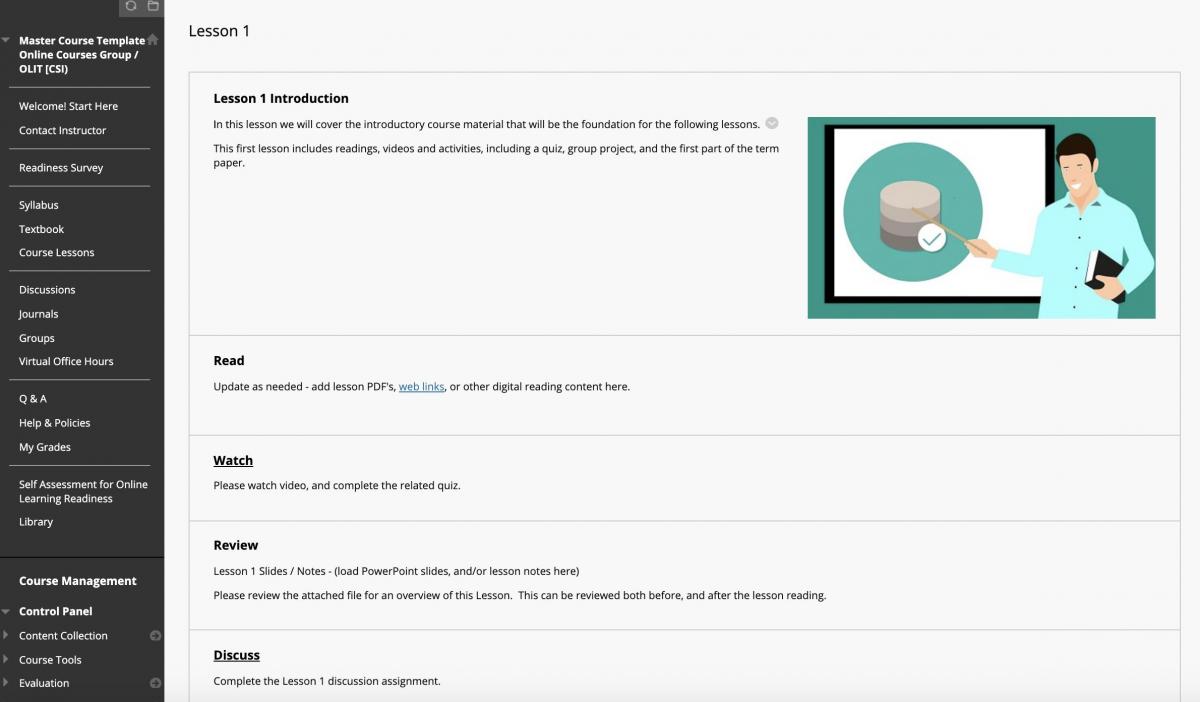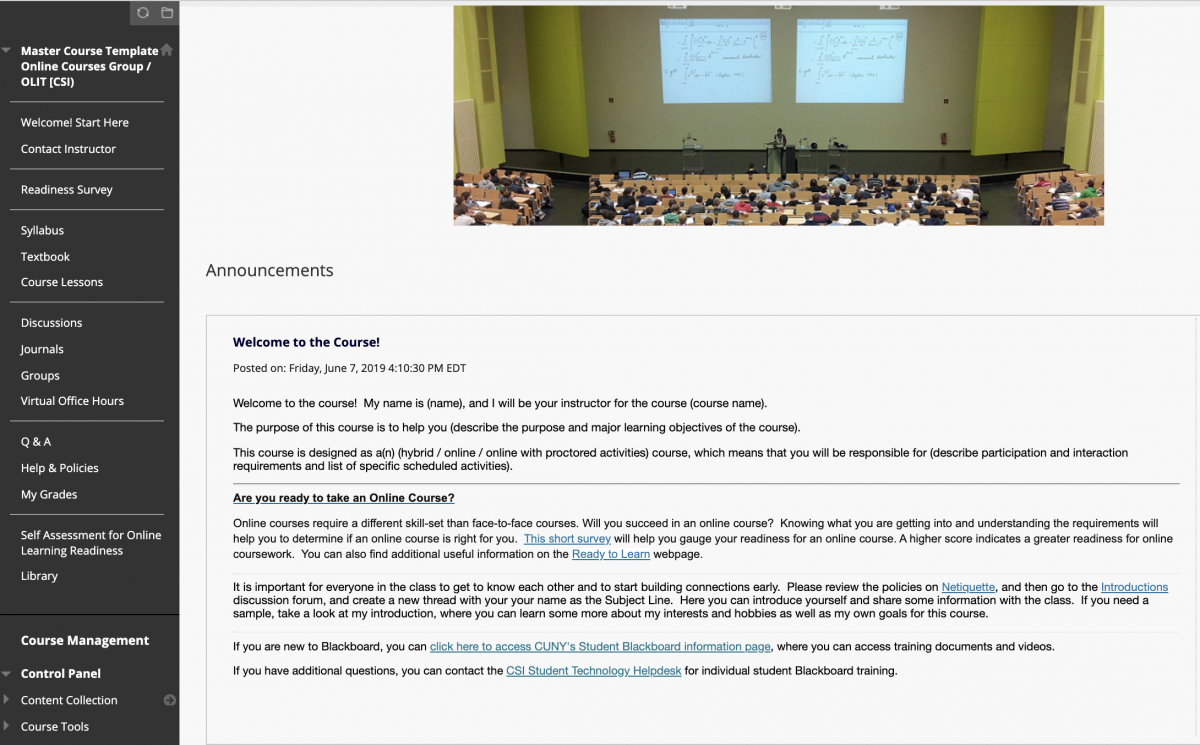 Students taking online courses for the first time may drop out because they feel confused and overwhelmed by the way the course is designed. An online course may include all of the information needed to learn but may not be structured in a way conducive to learning. Building on Kumar and Skrocki’s article “Ensuring Student Success in Online Courses” a few approaches listed below can help ensure that your course is easy for students to navigate:
Students taking online courses for the first time may drop out because they feel confused and overwhelmed by the way the course is designed. An online course may include all of the information needed to learn but may not be structured in a way conducive to learning. Building on Kumar and Skrocki’s article “Ensuring Student Success in Online Courses” a few approaches listed below can help ensure that your course is easy for students to navigate:
Provide a Course Overview
Since you may not have an opportunity to meet in person to share how the course is structured, it is important to explain the structure and layout of the course in writing or using media. A course tour, created as a video, can be a very helpful orientation for students.
Prepare Students for Taking an Online Course
Introduce them to some important considerations to prepare for by having them review the CSI website: Are you Ready? This website guides them to important technical resources to ensure they are familiar with how to use Blackboard.
Use Learning Units to Provide a Simple and Consistent Structure
Use learning units or modules to structure the course by week. This helps guide students to focus on what is important in a specific period of time, and helps avoid feeling overwhelmed by the information shared. Provide a consistent layout in each learning unit/module with headings to make it easy for students to follow from week to week. The CSI course template can help you get started.
Clearly Communicate Expectations
Provide detailed and very explicit instructions about the course format, assignments, expectations, grading criteria, etc. Provide a “Frequently Asked Questions” section with some of the questions and topics that students may have about the course. Provide rubrics and sample assignments. Consider setting up a “syllabus quiz” to ensure students understand the details in the syllabus.
Chunk the Content and Scaffold Instruction
Cognitive overload can creep into online courses when there is too much information provided at the same time. To avoid this, chunk content into sections to help students focus on what is most important at the right times. Semester long assignments work best online when they are scaffolded into sections. Each assignment can build on the next.
Humanize the Course
In online courses students may feel isolated or lonely due to the lack of face-to-face interaction. Instructors must be intentional about including personal interactions and collaboration since informal social learning is less likely to happen on its own. Start the course with icebreakers so students have an opportunity to get to know each other. Share a warm welcome message with students using video. Set up places in the course for informal sharing and questions such as an open Q & A discussion forum.
References:
Kumar, P., Skrocki, M. (2016) Ensuring Student Success in Online Courses, Faculty Focus, May 6, 2016
https://www.facultyfocus.com/articles/online-education/ensuring-student-success-online-courses/
CSI Course Template
CSI has developed a course template to ensure your course is structured in alignment with standards of quality for online and hybrid teaching. The master course template is designed according to standards of quality for online courses
It includes the following sections:
- Welcome! Start Here
- Contact Instructor
- Readiness Survey (for students)
- Syllabus
- Textbook
- Course Lessons
- Discussions (and other tools to support interaction)
- Virtual Office Hours
- Q & A
- Help & Policies
- My Grades
You may review the CSI Online Course Template in Blackboard.


Please contact the Online Learning Team if you would like a copy of this template or have any other questions.
Course Development Guidelines & Timeline
When teaching online or hybrid for the first time you will want to tackle your approaches to both: 1) Course Design and 2) Course Facilitation. The more attention you give to the course design phase, the smoother the course facilitation phase will go.
Course design follows an ADDIE model. The acronym "ADDIE" stands for Analyze, Design, Develop, Implement, and Evaluate. It is an Instructional Design tool that helps us think through a course's design, development, and delivery. ADDIE does not suggest of follow specific learning theories; it is a project management tool. Think of it as a "blueprint" for the course.
- Instructional System Design (ISD): Using the ADDIE Model.
- ADDIE Model: Instructional Design
- Sample ADDIE worksheet
Teaching online and hybrid is a front loaded design process. You will want to complete 90% of your course desiign at least a few weeks before the semester starts so that you can focus on facilitatin the course when it is in session. The CSI Online Learning Initiative (OLI) Team has developed the following recommended course design schedule. This can be accelerated based on your schedule.
Week #
Actions
Recommended Deliverables
1
Determine your readiness to teach online. What training and other support will you need to develop a high quality online/blended course?
- Complete the online teaching readiness survey:
- Request an initial consultation with a member of the Online Learning Initiative (OLI) Team.
- Request a copy of a course template from OLI. You may review the CSI Online Course Template in Blackboard.
2
Meet with Instructional Designers to begin the course design process; Discuss best practices with online/hybrid courses and standards of quality for online/hybrid courses. Review approaches to online assessment and interaction.
- Attend recommended training sessions, as needed.
- Review course design standards and schedule.
- Meet with a member of the Online Learning Initiative (OLI) Team
3
Revise syllabus based on input from OLI and begin to develop course components; Develop course schedule which includes weekly learning objectives and their aligned instructional activities and assessments.
- Attend training, as needed.
- Create a draft of new course outline.
- Chunk course into weekly modules/units.
- Use a Course Planning Tool
4
Develop weekly learning objectives, content, interaction and assessments for units/modules 1-5.
- Share the learning objectives, an introduction to the module, instructions for activities and assessments for the weeks 1-5.
- Record lectures or module introductions as needed.
- Add instructions to take the Student Survey – and requirements to view “Are you Ready?” online readiness website
- Distance Learning Website for Students
- Create icebreaker discussion for students.
5
Develop weekly learning objectives, content, interaction and assessments for units/modules 6-10.
- Share the learning objectives, an introduction to the module, instructions for activities and assessments for the weeks 6-10.
- Record lectures or module introductions as needed.
6
Develop weekly learning objectives, content, interaction and assessments for units/modules 11-15
- Share the learning objectives, an introduction to the module, instructions for activities and assessments for the weeks 11-15.
- Record lectures or module introductions as needed.
7
Develop course overview and introduction materials.
- Record instructor's welcome video.
- Create course welcome page (photo and bio)
- Create detailed instructions for students on any required technology, course-long projects, etc.
8
Finalize all assessments in the course.
- Finalize quizzes, tests, and test banks.
- Finalize all rubrics for assignments and discussions.
9
Evaluate the course and whether design standards have been met.
- Complete course design checklist with ID standards and rubrics.
10
Copy the course shell into the official course and make final revisions and adjustments.
- Seek assistance with course copying from OLI team.
- Refer to online teaching tips.
Testimonials
Professor George Vachadze comments:
Even as online education is taking off, most of the faculty members continue to fear that the record-high number of students taking those classes are receiving an inferior experience to what can be delivered in the classroom. Overcoming the skepticism will, of course, require a clear basis of regulation and maintenance of standards for all online courses and programs.
This new hybrid/online course initiative offered at CSI allowed me to work with technology and course design experts who not only enhanced my course design and delivery methods but also validated the idea that my course has merit and it provides the value to our students. I hope this program will continue in the coming semesters so that I can have an opportunity to innovate in that area.